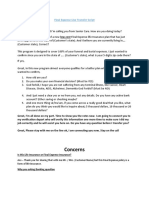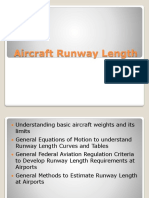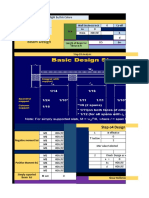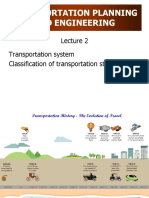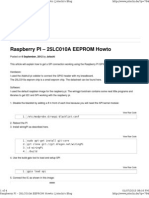0 ratings0% found this document useful (0 votes)
72 viewsTPE Lecture 7
Runway orientation is a critical part of airport planning and design. It depends on prevailing wind directions to maximize usability. Runways should be oriented to allow at least 95% usability with crosswinds below safety limits. Wind data like direction, speed, and duration are analyzed in a wind rose diagram to determine the optimal orientation. For the example airport, the primary runway was determined to be 90-270 degrees (East-West) to achieve 90.8% usability. A secondary crosswind runway at 30-210 degrees was also recommended to achieve over 95% total usability.
Uploaded by
Fortiter FysproCopyright
© © All Rights Reserved
Available Formats
Download as PDF, TXT or read online on Scribd
0 ratings0% found this document useful (0 votes)
72 viewsTPE Lecture 7
Runway orientation is a critical part of airport planning and design. It depends on prevailing wind directions to maximize usability. Runways should be oriented to allow at least 95% usability with crosswinds below safety limits. Wind data like direction, speed, and duration are analyzed in a wind rose diagram to determine the optimal orientation. For the example airport, the primary runway was determined to be 90-270 degrees (East-West) to achieve 90.8% usability. A secondary crosswind runway at 30-210 degrees was also recommended to achieve over 95% total usability.
Uploaded by
Fortiter FysproCopyright
© © All Rights Reserved
Available Formats
Download as PDF, TXT or read online on Scribd
You are on page 1/ 20
AIRPORT ENGINEERING
Lecture 7
Runway orientation, Runway configuration
Landing
Graphic shows planes
lined up to land at
O’Hare and Midway
Airports
Jan. 20, 2003
05:30 pm
RUNWAY ORIENTATION
Usability Factor
Definition: “the percentage of time during which the
use of a runway or system of runways is not restricted
because of cross wind component”
Usability of the runway depends upon the
metrological and topography of the site (use of
prevailing wind direction)
Cross wind component is a function of airplane mass
and the type of undercarriage
System of runways should provide at least 95%
usability factor
Runway Orientation
Critical task in the planning and design of an airport
Depends on direction of wind (oriented in the
prevailing direction of wind)
Utilize the available wind force at time of take-off and
landing (lift and drag)
Runway govern the orientation of the remaining
facilities (terminal building, parking, apron, taxiways
hanger, etc.)
Avoid delays in landing and take-off operation (least
interference)
Runway Orientation – cont’d
Provide shortest taxiway distance to terminal building
Provision of multiple taxiways
Provide adequate taxiways so that landing aircrafts
can exit runways as quickly as possible
Provide adequate separation with other facilities of
the airport and air traffic
Depends on topography of the area (requires
minimum grade changes)
Wind Direction Data
Wind direction
Head wind (from front)
Tail wind (from behind)
Cross wind (perpendicular)
Wind intensity (velocity in km/hr)
Wind duration
Direction of wind not same all year round
Cross Wind (CW) Component
Maximum CW depends on:
Size of aircraft
Wing configuration
Condition of pavement
For medium and light aircraft CW <= 25 kmph
ICAO recommendations:
Required Reference Field Length Max. CW Component
1500 m or more 37 kmph
1200 m to 1499 m 24 kmph
< 1200 m 19 kmph
Calm Period
Wind intensity remains below 6.4 kmph (4 mph)
Common to all directions and is added to the wind
coverage for any direction
Runway Orientation (Analysis of Wind)
The principal traffic runway should be oriented as
closely as practical in the direction of the prevailing
winds when the crosswind is excessive.
Guidelines are provided by ICAO and FAA for
maximum allowable crosswind under different
conditions
Runways should be oriented so planes may be landed
at least 95 percent of the time with cross wind
components not exceeding 15 mi/ h.
Wind Rose Diagram
Consists of series of concentric circles cut by radial
lines on polar-coordinate graph paper
Radial lines are used to scale
the wind magnitude
Each radial line is 22.5 degree.
Circle: wind is from SE,
between 20 to 25 mph,
3.0 percent of the time
Less than 4 mph is
referred as calm period
General Approach - wind rose (I)
Draw three equidistance parallel lines on a
transparent template. The middle line is the runway
center line and distance between outside lines
represents the allowable cross wind component
Template placed on the wind rose such that the
centerline passes through the center of wind rose
General Approach - wind rose (II)
Enter data for wind velocity,
direction and percentage of
wind in each direction
Using the template, rotate to
get the maximum wind
coverage
For fractional parts add the
appropriate percentages
Total area under template is
97 percent
EW is the best orientation, also
labeled as 9/27 (90 and 270
degree from north)
Example (Wind Data)
Example Solution (I)
Example Solution (II)
Primary runway
Computed wind coverage
is 90.8 percent
Greater than 95 % is
required
The runway designation
are:
90o to 270o
N 90 E to S 90 W
9/27 or 9-27
Requires cross wind
runway
Example Solution (III)
Proposed cross wind
runway direction
N 30 E to S 30 W
3/21 or 3-21
Total coverage equal
to 85.8 percent
Additional coverage =
5.8 percent
Total= 90.8+5.8 =
96.6 percent
Example Solution (IV)
Percentage of Time in Specific Direction
QUESTIONS ???
You might also like
- Concerns: Final Expense Live Transfer ScriptNo ratings yetConcerns: Final Expense Live Transfer Script4 pages
- UNIT-3 Airport Engineering Airport EngineeringNo ratings yetUNIT-3 Airport Engineering Airport Engineering10 pages
- Runway Design: Prepared By:-Dr. Vaibhav SharmaNo ratings yetRunway Design: Prepared By:-Dr. Vaibhav Sharma34 pages
- AIRFIELD: It Is An Area Where An Aircraft Can Land and Take Off, Which May or M A y Not Be Equipped With Any Navigational Aids or MarkingsNo ratings yetAIRFIELD: It Is An Area Where An Aircraft Can Land and Take Off, Which May or M A y Not Be Equipped With Any Navigational Aids or Markings8 pages
- # Runways and Connecting Taxiways Should Be Arranged So As To100% (1)# Runways and Connecting Taxiways Should Be Arranged So As To11 pages
- Lecture 6: Runway Length: Dr. Ankit Gupta, Assistant ProfessorNo ratings yetLecture 6: Runway Length: Dr. Ankit Gupta, Assistant Professor55 pages
- Christ Billy P - 03111540000072 - AE2017 Mid ExamNo ratings yetChrist Billy P - 03111540000072 - AE2017 Mid Exam9 pages
- Lecture 04 _ Definitions and Aerodrome Data Airport and Pavement ClassificationNo ratings yetLecture 04 _ Definitions and Aerodrome Data Airport and Pavement Classification24 pages
- Aircraftcharacteristics 150420075140 Conversion Gate02No ratings yetAircraftcharacteristics 150420075140 Conversion Gate0236 pages
- Training Report: B.Tech in Aerospace Engineering (Btae)No ratings yetTraining Report: B.Tech in Aerospace Engineering (Btae)101 pages
- Lectut CEN 307 PDF Airport Runway Orientation100% (1)Lectut CEN 307 PDF Airport Runway Orientation54 pages
- Railway Engineering & Runway EngineeringNo ratings yetRailway Engineering & Runway Engineering42 pages
- The Samora Machel and Helderberg Conspiracies and Other South African Air AccidentsFrom EverandThe Samora Machel and Helderberg Conspiracies and Other South African Air AccidentsNo ratings yet
- Beam Design: Enter Value Highlight by This ColureNo ratings yetBeam Design: Enter Value Highlight by This Colure122 pages
- Aints Namels and Arnishes: ClassificationNo ratings yetAints Namels and Arnishes: Classification10 pages
- Transportation Planning and Engineering: Transportation Planning Process (Data Collection Methods - Cont'd)No ratings yetTransportation Planning and Engineering: Transportation Planning Process (Data Collection Methods - Cont'd)17 pages
- F 168 Mpa F 140 Mpa: Capacity of Rectangular Sections (WSD) F'C 35 MpaNo ratings yetF 168 Mpa F 140 Mpa: Capacity of Rectangular Sections (WSD) F'C 35 Mpa10 pages
- Transportation Planning and EngineeringNo ratings yetTransportation Planning and Engineering29 pages
- Transportation Planning and EngineeringNo ratings yetTransportation Planning and Engineering11 pages
- Transportation Planning and Engineering: Airport Master Plan, and Airport Financing100% (2)Transportation Planning and Engineering: Airport Master Plan, and Airport Financing28 pages
- Master Thesis Proposal: Use of Waste Plastic in Flexible PavementsNo ratings yetMaster Thesis Proposal: Use of Waste Plastic in Flexible Pavements7 pages
- Transportation Planning and Engineering: Introduction To Airport EngineeringNo ratings yetTransportation Planning and Engineering: Introduction To Airport Engineering54 pages
- Design Population 8410 Persons: V 1/n R SNo ratings yetDesign Population 8410 Persons: V 1/n R S5 pages
- The Goodness of Garlic: (Stabilized Allicin)No ratings yetThe Goodness of Garlic: (Stabilized Allicin)4 pages
- Gaussian Noise & All Filters (Matlab Code)100% (10)Gaussian Noise & All Filters (Matlab Code)4 pages
- Aims and Objectives - What's The Difference?: June 9, 2014 Pat ThomsonNo ratings yetAims and Objectives - What's The Difference?: June 9, 2014 Pat Thomson2 pages
- Class 10 Ut-1 Date Sheet - Ut-1 SyllabusNo ratings yetClass 10 Ut-1 Date Sheet - Ut-1 Syllabus8 pages
- Peace Corps OST Focus In/Train Up (FITU) Focus in - Train Up Action PlanNo ratings yetPeace Corps OST Focus In/Train Up (FITU) Focus in - Train Up Action Plan2 pages
- Since 1989 Da Milano Is An Integral Leather Brand That Manufactures and Retails High End Leather Bags and Accessories For Both Men and Women100% (1)Since 1989 Da Milano Is An Integral Leather Brand That Manufactures and Retails High End Leather Bags and Accessories For Both Men and Women21 pages
- tc1972en-ed05_limits_and_dimensioning_for_omnipcx_office_rce_release_10.3No ratings yettc1972en-ed05_limits_and_dimensioning_for_omnipcx_office_rce_release_10.316 pages
- Ash Handling System: in A 210 M.W Boiler, The Coal Consumption Is 3,500 M.T S Per Day The Ash Content Is 1,400 M.T SNo ratings yetAsh Handling System: in A 210 M.W Boiler, The Coal Consumption Is 3,500 M.T S Per Day The Ash Content Is 1,400 M.T S22 pages
- Module 2 - Handout 2.0 - Demand Theory, Analysis and EstimationNo ratings yetModule 2 - Handout 2.0 - Demand Theory, Analysis and Estimation4 pages
- Stakeholder Analysis Matrix (3.3.2) (10.1)No ratings yetStakeholder Analysis Matrix (3.3.2) (10.1)1 page
- Works - Design.and - Management.2nd - Edition.jan.2009.ebook DDU100% (1)Works - Design.and - Management.2nd - Edition.jan.2009.ebook DDU522 pages
- Department of Education: Philippine Contemporary Arts in The Region Quarter3-Week3-4No ratings yetDepartment of Education: Philippine Contemporary Arts in The Region Quarter3-Week3-46 pages
- St. Bernard Parish Gov't v. United States, No. 05-1119L (Fed. Cl. May 1, 2015)100% (1)St. Bernard Parish Gov't v. United States, No. 05-1119L (Fed. Cl. May 1, 2015)74 pages
- AIRFIELD: It Is An Area Where An Aircraft Can Land and Take Off, Which May or M A y Not Be Equipped With Any Navigational Aids or MarkingsAIRFIELD: It Is An Area Where An Aircraft Can Land and Take Off, Which May or M A y Not Be Equipped With Any Navigational Aids or Markings
- # Runways and Connecting Taxiways Should Be Arranged So As To# Runways and Connecting Taxiways Should Be Arranged So As To
- Lecture 6: Runway Length: Dr. Ankit Gupta, Assistant ProfessorLecture 6: Runway Length: Dr. Ankit Gupta, Assistant Professor
- Lecture 04 _ Definitions and Aerodrome Data Airport and Pavement ClassificationLecture 04 _ Definitions and Aerodrome Data Airport and Pavement Classification
- Aircraftcharacteristics 150420075140 Conversion Gate02Aircraftcharacteristics 150420075140 Conversion Gate02
- Training Report: B.Tech in Aerospace Engineering (Btae)Training Report: B.Tech in Aerospace Engineering (Btae)
- Der schnelle Weg zum Flugfunkzeugnis für IFRFrom EverandDer schnelle Weg zum Flugfunkzeugnis für IFR
- The Samora Machel and Helderberg Conspiracies and Other South African Air AccidentsFrom EverandThe Samora Machel and Helderberg Conspiracies and Other South African Air Accidents
- Transportation Planning and Engineering: Transportation Planning Process (Data Collection Methods - Cont'd)Transportation Planning and Engineering: Transportation Planning Process (Data Collection Methods - Cont'd)
- F 168 Mpa F 140 Mpa: Capacity of Rectangular Sections (WSD) F'C 35 MpaF 168 Mpa F 140 Mpa: Capacity of Rectangular Sections (WSD) F'C 35 Mpa
- Transportation Planning and Engineering: Airport Master Plan, and Airport FinancingTransportation Planning and Engineering: Airport Master Plan, and Airport Financing
- Master Thesis Proposal: Use of Waste Plastic in Flexible PavementsMaster Thesis Proposal: Use of Waste Plastic in Flexible Pavements
- Transportation Planning and Engineering: Introduction To Airport EngineeringTransportation Planning and Engineering: Introduction To Airport Engineering
- Aims and Objectives - What's The Difference?: June 9, 2014 Pat ThomsonAims and Objectives - What's The Difference?: June 9, 2014 Pat Thomson
- Peace Corps OST Focus In/Train Up (FITU) Focus in - Train Up Action PlanPeace Corps OST Focus In/Train Up (FITU) Focus in - Train Up Action Plan
- Since 1989 Da Milano Is An Integral Leather Brand That Manufactures and Retails High End Leather Bags and Accessories For Both Men and WomenSince 1989 Da Milano Is An Integral Leather Brand That Manufactures and Retails High End Leather Bags and Accessories For Both Men and Women
- tc1972en-ed05_limits_and_dimensioning_for_omnipcx_office_rce_release_10.3tc1972en-ed05_limits_and_dimensioning_for_omnipcx_office_rce_release_10.3
- Ash Handling System: in A 210 M.W Boiler, The Coal Consumption Is 3,500 M.T S Per Day The Ash Content Is 1,400 M.T SAsh Handling System: in A 210 M.W Boiler, The Coal Consumption Is 3,500 M.T S Per Day The Ash Content Is 1,400 M.T S
- Module 2 - Handout 2.0 - Demand Theory, Analysis and EstimationModule 2 - Handout 2.0 - Demand Theory, Analysis and Estimation
- Works - Design.and - Management.2nd - Edition.jan.2009.ebook DDUWorks - Design.and - Management.2nd - Edition.jan.2009.ebook DDU
- Department of Education: Philippine Contemporary Arts in The Region Quarter3-Week3-4Department of Education: Philippine Contemporary Arts in The Region Quarter3-Week3-4
- St. Bernard Parish Gov't v. United States, No. 05-1119L (Fed. Cl. May 1, 2015)St. Bernard Parish Gov't v. United States, No. 05-1119L (Fed. Cl. May 1, 2015)

